Dolphins are beautiful, intelligent, playful, and packed with complex social behaviors. But how much do you know about the different types of dolphins? There are more kinds of dolphins than you would imagine, and we are about to let you in on their unique appearances, behavior, and habitats.
View in gallery
First off, dolphins are a species of their own, right? Wrong; they are a diverse group of aquatic mammals.
Just how many species of dolphins are there? We know of about 49 types of dolphins, porpoises, and whales within the order Cetacea, but these differ in their characteristics and habitats.
Moreover, dolphins fall into four extant families: Iniidae, Pontoporiidae, Delphinidae, and Platanistidae. While some of the members of these families are pretty common, others are rare or even extinct.
The most common dolphins belong to the Delphinidae family, and they include the bottlenose dolphin, Orca (killer whale), and common dolphin, just to mention a few.
Sounds confusing, right?
It doesn’t have to be. Today, we discuss 27 different types of dolphins, with a primary focus on the extant types. Read on to master how to distinguish these incredible animals based on their features and distinct characteristics.
Table of Contents
What Type of Animal Is a Dolphin, Exactly?
So, are dolphins a type of whale?
Of all aquatic mammals, dolphins are perhaps the most recognized. These beautiful creatures are related to whales, although they have leaner bodies and elongated beaks with clever grins.
All dolphins are whales, but not all whales are dolphins!
What Are the Different Kinds of Dolphin?
Over the centuries, researchers have used different systems in an attempt to categorize dolphin species accurately. In this post, we will classify different types of dolphins based on their habitats.
Related Reading: Types of Sharks Explained
There are two types of dolphins based on where they dwell. They include:
- River dolphins
- Ocean dolphins
Without further ado, let’s take a look at the different types of dolphins!
21 Sea Dolphin Species
Oceanic dolphins dwell primarily in the sea. Compared to river-dwelling types of dolphins, there are more oceanic cetaceans.
A good number of these mammals are extinct or remain poorly researched. We will discuss the 21 most common oceanic dolphin species.
1. Common Bottlenose Dolphin (Tursiops truncatus)
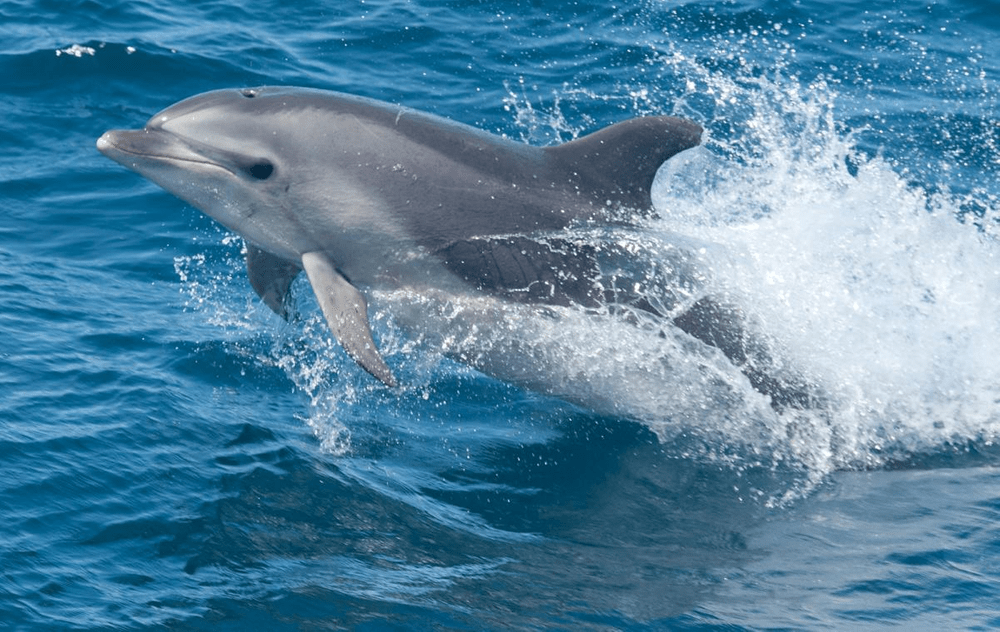
Let’s begin with the most famous dolphin species—the common bottlenose dolphin.
You can find these kinds of dolphins in almost all the oceans worldwide, although they tend to avoid the extreme south and north latitudes.
The reason behind this is that they dwell in temperate and warm waters. Therefore, you can find them in coastal waters and offshore, including in gulfs, bays, and harbors.
Common bottlenose dolphins have a diverse diet that includes slew, eels, shrimp, eels, squid, and a whole range of fish varieties. They use sound for hunting for food and communicating.
Contrary to popular belief, this dolphin species is also endangered because of human activity, pollution, and the high risk of human-related harassment, injury, or death.
Characteristics
- Grayish black body with a light gray belly
- Short, thick snout
- Often travel in groups but could be spotted as individuals
- They swallow their fish whole instead of chewing it
- The average lifespan is about 40 for females and 60 for males
- Females give birth after 3—6 years
2. Orca/Killer Whale (Orcinus orca) — Largest Dolphin
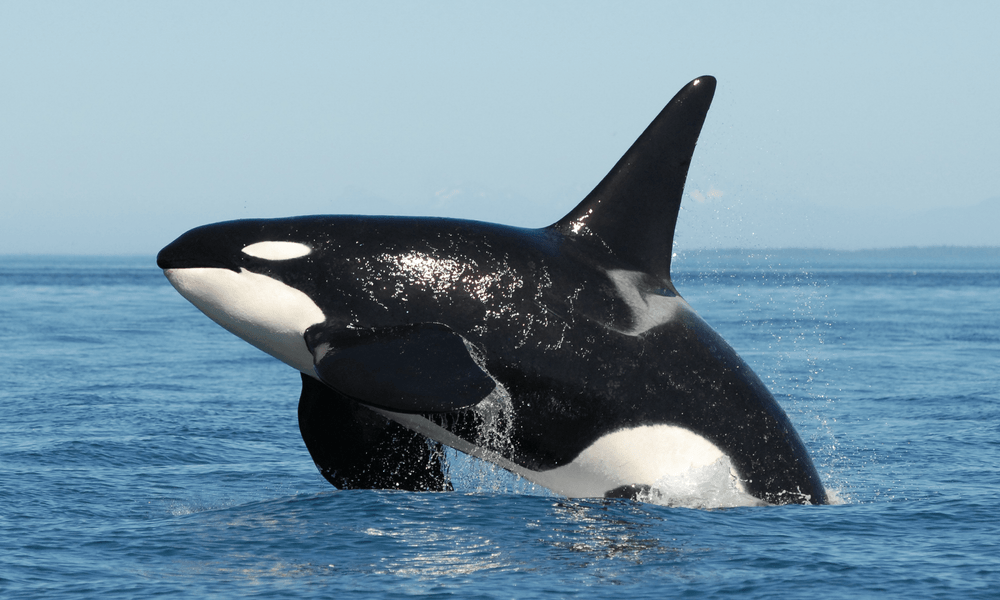
One of the most famous dolphin names you’ve probably heard is the killer whale. Like all dolphins, the orca is a whale.
What sets it apart from other types of dolphins is that it is toothed and belongs to the Delphinidae family.
The killer whales are the largest dolphins worldwide and can grow over 26 feet (8 meters) long and weigh as much as 7,000 lbs. (3175 kg).
Another unique fact is that killer whales are called “whale killer.” We can all agree that it’s easier to flip around the words and call the oceanic mammal a killer whale.
This dolphin is a top hunter known to feast on other types of large whales, but unlike predators like sharks, it rarely attacks humans. Moreover, there are four subcategories of orcas that differ in size based on their habitat.
Characteristics
- Black and white body with a long dorsal fin
- Cylindrical body with pointed ends for incredible speed despite the size and weight
- Massive teeth that can grow as long as 10 centimeters (4 inches)
- Males are bigger than females and can grow as long as 9.8 meters (32 feet)
- A mature male can weigh a staggering 22,000 lbs. (10,000 kg)
- Highly intelligent with coordinated hunting tactics
3. False Killer Whale (Pseudorca crassidens)
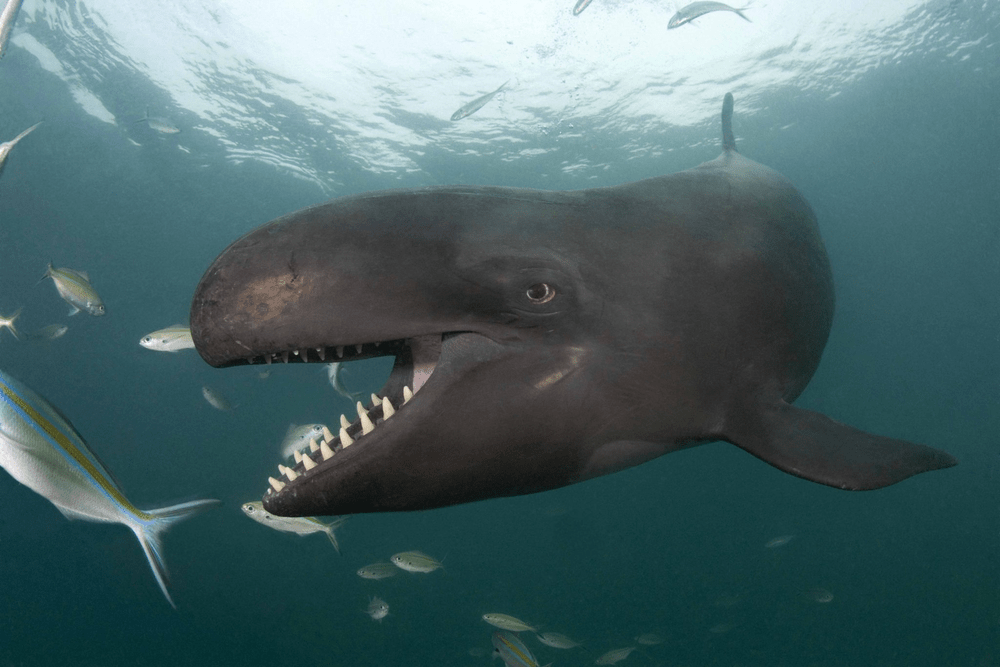
The false killer whale is a great fan of tropical regions, although you can find it in just about all oceans worldwide.
As the name suggests, the large cetacean closely resembles the killer whale (orca), although some key differences exist between them. For instance, the false killer whale has a more petite body and no white spots on its black or dark gray body.
Different types of dolphins are inherently social and will travel in groups of 15-20 individuals. However, the false killer whale takes social interactions a notch higher and could travel in groups of up to 500 dolphins.
While it’s infamous for hunting other dolphin species, it remains non-aggressive towards the common bottlenose dolphins and Pacific white-sided cetaceans.
Characteristics
- Rounded head, small dorsal fin with a dark gray body
- Mature false killer whales can grow up to 6 meters (20 feet)
- Can weigh up to 3,000 lbs. (1360 kg)
- Capable of forming strong social bonds with peers that last for years
- Cooperative hunters that often travel in groups
- A maximum lifespan is 63 years for females and 58 years for males
4. Hourglass Dolphin (Sagmatias cruciger)

Hourglass dolphins, also known as sea cows, have a short, stocky body with a tall, curved dorsal fin.
It has a black body with two white bands that narrow down in the middle to create an hourglass illusion. These dolphins mainly dwell in the Drake Passage between South America and the Antarctic waters.
Like most oceanic cetaceans, the hourglass dolphins are social creatures that often swim in pods of 100 or more individuals.
They feed on squid, fish, and crustaceans, and while the numbers may not be accurate, researchers say there are about 144,300 hourglass dolphins in the Antarctic convergence alone.
Characteristics
- Hourglass dolphins prefer living in cold oceanic waters
- Adults can grow up to 6 feet long and weigh about 265 lbs. (120 kg)
- Killer whales are the only known natural predators of the hourglass dolphins
5. Atlantic Spotted Dolphin (Stenella frontalis)

Atlantic spotted dolphins are a dolphin species mainly found in the Atlantic Ocean’s tropical or warm temperate waters. Again, this type of dolphin is a social creature that roams in groups of 50—100 individuals.
Looks-wise, they resemble the bottlenose dolphins, although adult Atlantic spotted dolphins have distinct spotted patterns while their young ones have no spots.
Scientists estimate the Atlantic spotted dolphins’ population to be at 77,000 worldwide. These incredible oceanic mammals dwell in the Western North Atlantic stock, Northern Gulf of Mexico stock, the S. Virgin Islands stock, and Puerto Rico stock.
While their estimated lifespan remains unknown, the dolphins reach sexual maturity at 8-15 years old.
Characteristics
- A robust body with a curved dorsal fin and moderately long beak
- Can grow as long as 7.5 feet long and weigh about 315 lbs. (142 kg)
- Cone-shaped teeth and rounded forehead for collecting sounds
- Incredibly acrobatic and fast swimmers
- Travel in groups and have well-coordinated hunting tactics
6. Dusky Dolphin (Sagmatias obscurus)

Dusky dolphins are acrobatic and are best known for their jaw-dropping aerial behavior.
They have white tummies, and their bodies have a dusky bluish-black hue with two creamy lines between the tail and dorsal fin.
An aspect that distinguishes the dusky dolphin from most types of dolphins is that it doesn’t have a beak. Another unique feature is that its head slants evenly from the blowhole to the snout’s tip.
The dusky dolphin is a close cousin of the Pacific White-Sided dolphin. However, it has a genetically distinct structure that sets it apart, not to mention the large concentrations of grey that make it visually unique.
You can find this dolphin species in the coastal waters around Australia, South Africa, South America, and New Zealand.
Characteristics
- Adults can reach roughly 7 feet long and weigh as much as 265 lbs. (120 kg)
- Have sharp cone-shaped teeth for firmly holding their prey
- Travel in pods of 10- 20 individuals
- Tend to be more active at night and coordinate hunting tactics within the group
- Communicate using clicks
- Reach sexual maturity at age 4-5 and have a lifespan of about 20 years
7. Hector’s Dolphin (Cephalorhynchus hectori) — Smallest Dolphin
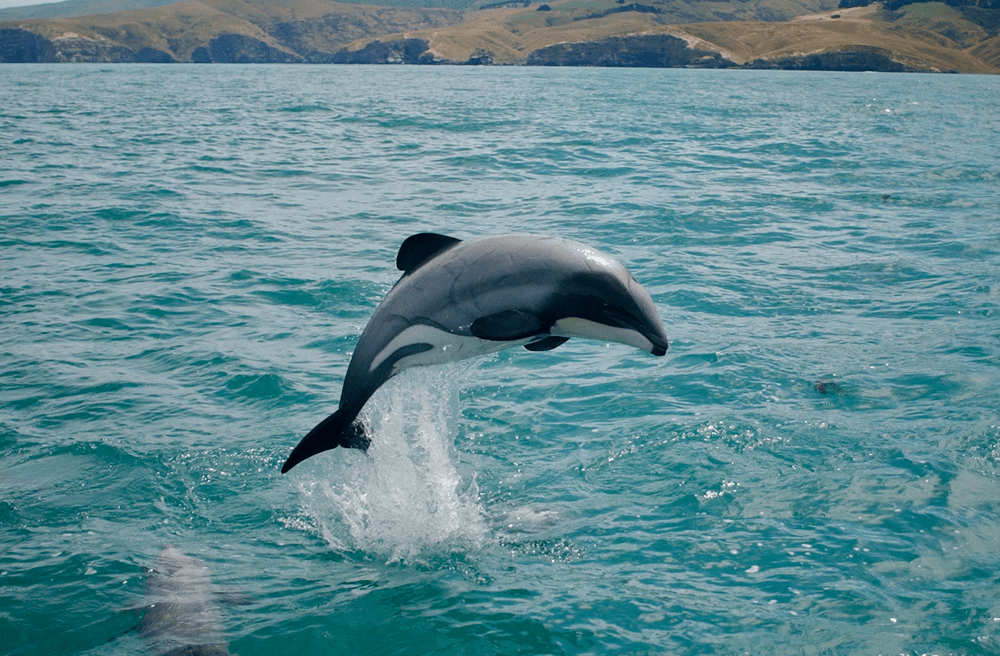
There are two Hector’s dolphin subspecies: the Māui dolphin and South Island Hectors. While the former dwells on North Island’s western coast, the latter primarily lives in New Zealand’s coastal waters.
The Hector’s dolphin is the rarest and smallest oceanic dolphin species worldwide.
The longest Hector’s dolphin doesn’t grow beyond 5 feet (152 cm) and will only weigh about 130 lbs. (58 kg). Hector’s dolphins also have no discernible beak and a more rounded dorsal fin like the Dusky dolphin.
Unfortunately, there are only about 7,300 individuals left of this dolphin breed.
Characteristics
- Short, stocky body with a pale grey complexion
- Relatively large fluke
- Females of both subspecies are larger than the makes
- Travel in small groups of about 20 individuals
- Have a lifespan of an average of 22 years
8. Spinner Dolphin (Stenella longirostris)
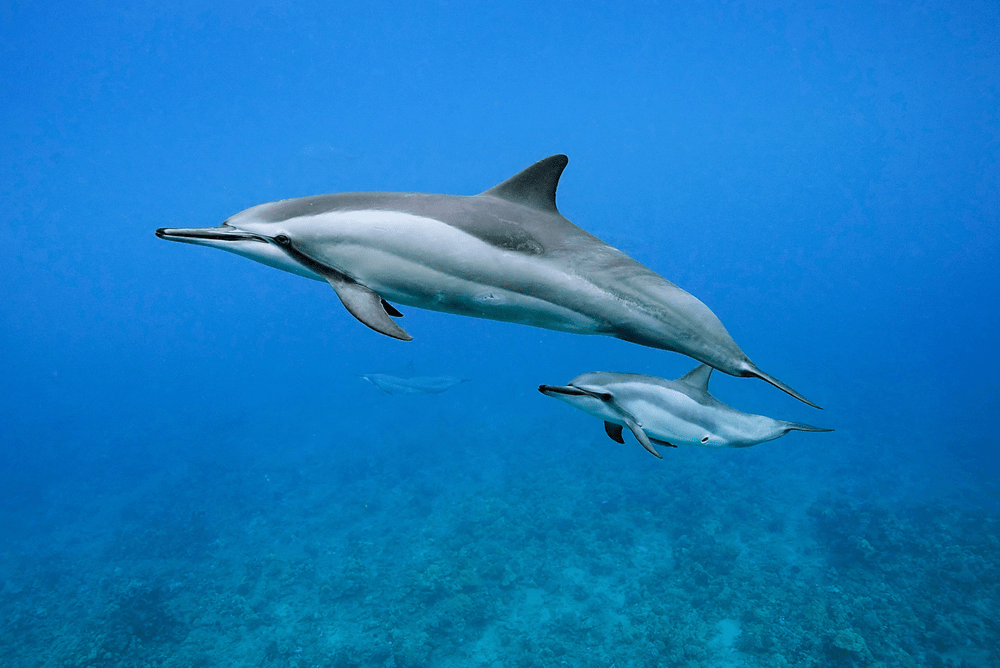
Like the Dusky dolphin, Spinner dolphins are also famous for their acrobatic abilities. This beautiful creature can leap from the water and spin up to seven times in the air before diving back into the water.
The dolphin breed is also called the long-snouted dolphin. The term “longirostris” means “long beak” in Latin.
The Spinner dolphin primarily dwells in deep waters where it has a good chance of tracking prey. You can find it in the Hawaiian subtropical waters, mainly in the deep offshore waters.
The dolphin breed reaches sexual maturity at seven years and has a 20-25 years life expectancy.
Characteristics
- There are four spinner dolphin subcategories that dictate the body hue of the cetacean
- Relatively smaller body compared to other oceanic types of dolphins
- Adults can be as long as 6.8 feet, weighing about 181 lbs. (82 kg)
- Often feed at night and hunt in groups
9. Southern Right Whale Dolphin (Lissodelphis peronii)

The Southern Right whale has a stocky black body, large head, and white tummy. Some of the physical features that make the cetacean unique are the patches around the chin.
Moreover, it has no dorsal fin but has broad paddle-like flippers. Mature Southern Right dolphins can range between 43- 56 feet in length and weigh a staggering 176,000 lbs. (79,833 kg).
Another unique fact about the dolphin species is that it dwells along the Southern Hemisphere. The dolphins move to low latitudes to find breeding grounds and migrate to high latitudes to find food.
Characteristics
- Easy to identify because of the sleek body and no dorsal fin
- Pretty acrobatic and can jump out of the water entirely before diving back
- Have a life expectancy of up to 70 years
- Mainly found in colder waters
10. Long-Finned Pilot Whale (Globicephala melas)

The long-finned pilot whale arguably has the most complex social interactions among all types of dolphins.
Apart from living in large schools of over 100 individuals, these cetaceans separate into tight pods of 10-20 individuals when hunting.
They are close cousins of the short-finned pilot whales, and the two dolphin breeds are nearly indistinguishable.
Long-finned pilot whales are anti-tropical and favor sub-polar or deep temperate waters. There are three subspecies of the cetacean, including the Western North Pacific, North Atlantic, and Southern Hemisphere long-finned pilot whale.
Depending on the habitat, males can live between 35 and 45. The females, however, have a longer lifespan of up to 60 years.
Characteristics
- Often black but may appear pale gray with whitish marks
- Stocky, sturdy body with a bulbous forehead
- Long, pointed, sickle-shaped flippers
- A thick dorsal fin that grows rounder and broader with maturity
- Have the most prolonged gestation period of 12—16 months
- Calves can measure up to 6.5 feet at birth and weigh up to 165 lbs. (74 kg)
11. Short-Finned Pilot Whale (Globicephala macrorhynchus)
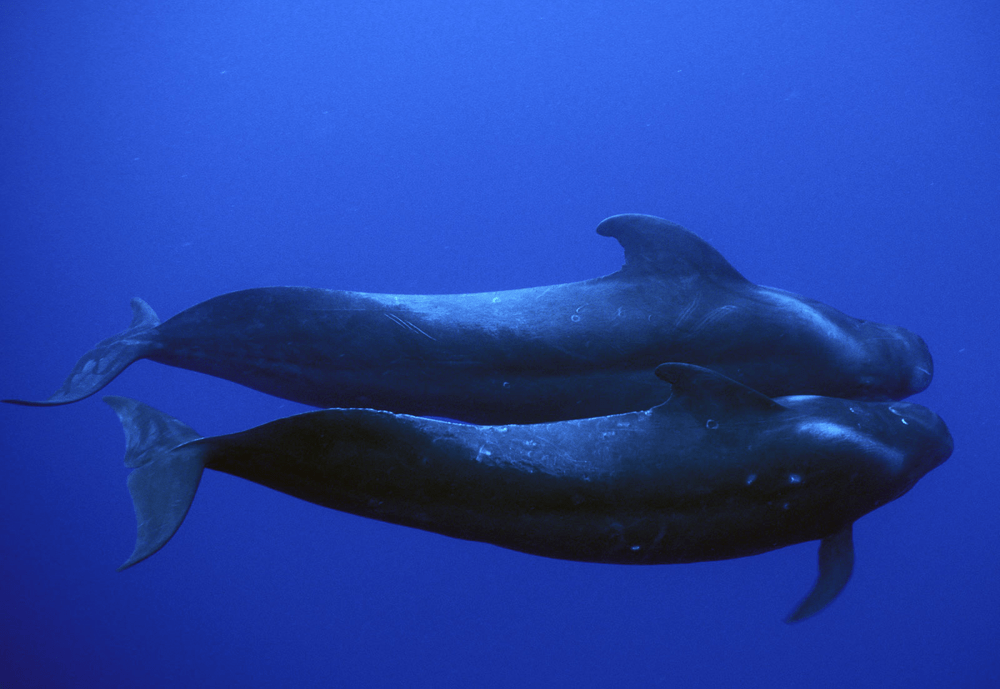
Unlike the long-finned pilot whale that is anti-tropical, the short-finned pilot whale favors temperate and tropical waters.
They can be found in just about all oceans globally, including the eastern tropical Pacific Ocean, U.S. west and east coasts in the Hawaiian Islands, and Santa Catalina Island.
It’s also worth mentioning that while it looks just like its long-finned cousin, there are stuck differences in the size, coloration, pattern, and features of these two dolphin breeds.
Short-finned pilot whales have bulbous heads with no apparent rostrum. Also, their dorsal fin has a more extended base and is positioned relatively forward on the body.
Characteristics
- Black/dark brown complexion with a large gray patch behind the dorsal fin
- Live in groups 15-30 with a female to male ratio of 8:1
- Can dive deep into water at high speeds when hunting (dubbed cheetahs of the deep sea)
- Reach sexual maturity by the age of 10
- Males have a life expectancy of 45 years, while females can live up to 60 years
12. Commerson’s Dolphin (Cephalorhynchus commersonii)

The Commerson’s dolphin, also called the panda dolphin or jacobita, is top on the smallest types of dolphins list. Upon maturity, the oceanic mammal can reach a maximum of 5.5 feet in length and weigh a mere 130 lbs. (58 kg).
The cetacean favors shallow waters and can be found around harbors and bays.
This dolphin breed is divided into two subspecies that dwell in the Kerguelen Islands and South America’s southern coast.
Commerson’s dolphins’ preferred habitat increases their risk of being hunted by humans for their meat, oil, and skin. It doesn’t help that they are easy to spot with their all-white bodies.
Characteristics
- Stocky body, rounded flippers, and an unnoticeable beak
- Acrobatic and can leap out of water and spin before diving back
- Despite the small size, the dolphins are foodies with fast metabolisms (can eat 10% of their weight daily)
- Can travel as individuals or in pods of 10- 15 individuals
- Reach sexual maturity between 5- 8 years and can live for 10- 18 years
13. Long-Beaked Common Dolphin (Delphinus delphis)

The long-beaked dolphin has a sleek body measuring 6-8.5 feet long. Adults can weigh anywhere between 160 lbs. (72 kg) and 500 lbs. (226 kg).
They have a considerably long rostrum (beak) with 47-67 fang-like teeth on either jaw. Another distinct feature is the relatively long, triangular-shaped dorsal fin.
Unlike most types of dolphins where the female is larger, long-beaked males are nearly 5% larger than the females.
The cetaceans have an iconic hourglass pattern because of their dark backs and dull yellow hue on the sides. While the bodies of juveniles have a muted shade, adults have a more extravagant complexion.
Characteristics
- Mainly dwell in shallow subtropical or tropical waters
- They can be found in the Indian, Atlantic, and Pacific oceans
- Reach sexual maturity at 10 years
- Can live up to 40 years
14. Short-Beaked Common Dolphin (Delphinus delphis)

Like the long-beaked dolphins, the short-beaked dolphins are abundant and quite widespread across the globe. They favor cool to warm tropical waters and primarily dwell offshore.
You can find them in the western North Atlantic, the U.S east coast, Black Sea, southwest Pacific, and the Mediterranean Sea. The long and short-beaked dolphin breeds have significant differences in their size, features, and habitat preferences.
Moreover, these oceanic cetaceans are social creatures typically found in groups of nearly 100 individuals. Larger groups often have subgroups of 20- 30 individuals that are either related or separated by their gender or age.
These high social dolphin species are energetic and acrobatic. If you’re lucky, you may just see them somersault in the air while navigating deep waters.
Characteristics
- Light gray body with a narrow dark stripe extending from the jaw to the flippers
- Small bodies measuring 6 feet or shorter
- Have an hourglass image on their back
- Can way up to 170 lbs. (77kg)
- Reach sexual maturity at 10 years and have an estimated lifespan of 35 years
15. Rough-Toothed Dolphin (Steno bredanensis)

The rough-toothed dolphins dwell in just about all waters worldwide that are tropical and warm temperate.
They can grow as long as 8.5 feet and weigh roughly 350 lbs. (158 kg). The long beak with a smooth slope from the forehead to the nib is among their unique physical attributes.
Moreover, these cetaceans have enormous flippers and an equally big dorsal fin.
This dolphin species gets its name from the appearance of its teeth. They have deep ridges that somewhat look like a saw. You can find the rough-toothed dolphins in pairs or groups of up to 20 individuals.
Another unique aspect is that, unlike most types of oceanic dolphins, this cetacean adapts well to captivity.
Characteristics
- Dark gray body with white lips and throat and spotted underside
- Reptilian-like appearance (pretty distinct)
- Can remain submerged in water for about 15 minutes
- Social and relate well with other types of dolphins including spinner, and bottlenose dolphins
- The dolphins are sexually mature between the age of 10 and 14
- A lifespan of 36 years on average
16. Clymene Dolphin (Stenella clymene)
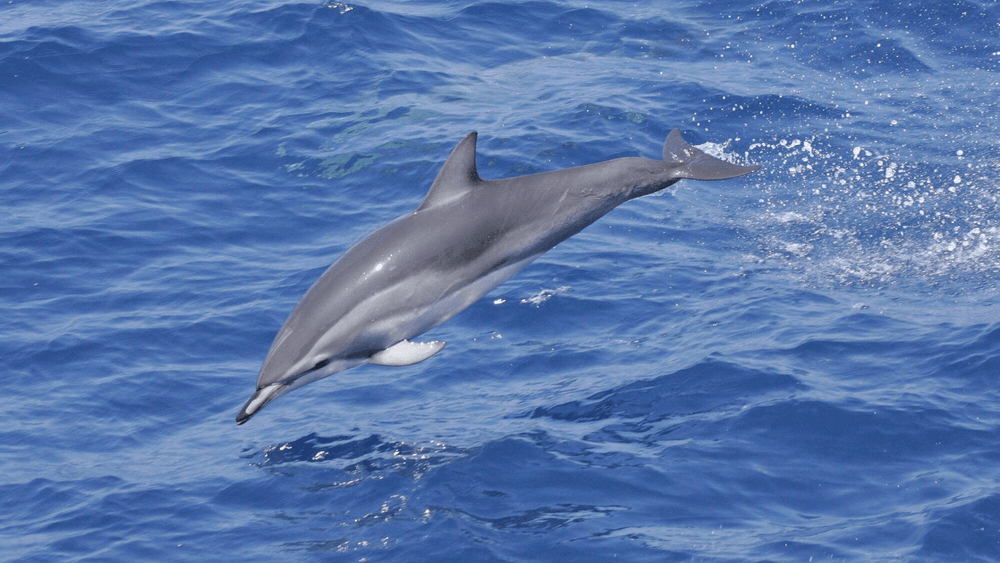
The Clymene dolphin primarily dwells in the Atlantic Ocean and remains one of the most impressive and unique dolphin breeds. The cetacean is a hybrid between the spinner and striped dolphin.
Note that this dolphin species is the only one confirmed to have originated from hybridization.
Socially, the Clymene dolphin is curious and playful. Groups of up to 150 individuals can swim up to a boat or ship and bow-ride off the vessel’s fore.
They are also called “short-snouted spinner dolphins” because they typically spin when they jump out of the water as they showcase their acrobatic skills.
Characteristics
- Dark gray back with a pale gray underside and light gray sides
- Streamlined bodies with a long, curved dorsal fin and moderately short beak
- Adults can grow up to 6.5 feet long and weigh about 200 lbs. (90 kg)
- Acrobatic swimmers
17. Indo-Pacific Humpback Dolphin (Sousa chinensis)
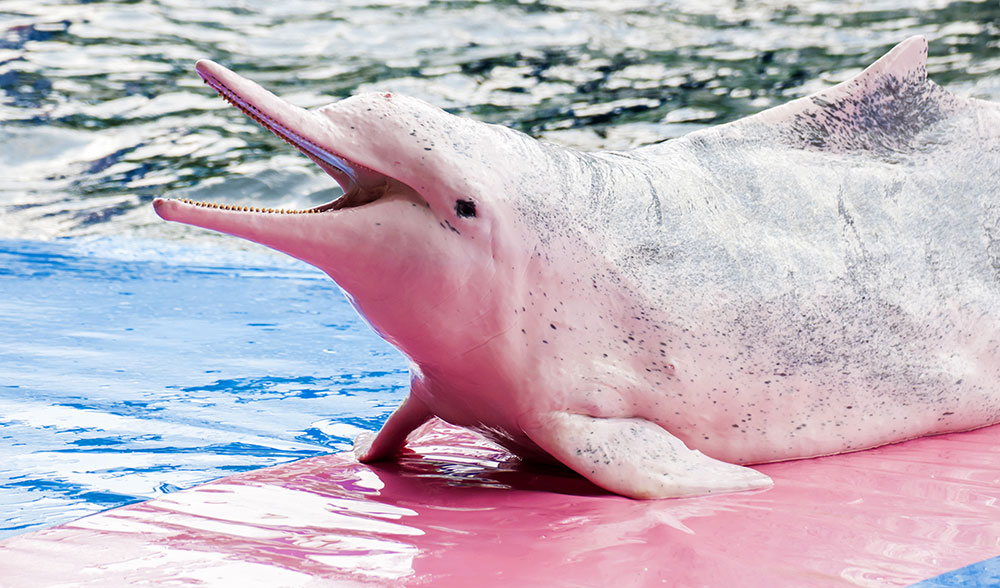
The Indo-Pacific humpback dolphin dwells primarily in southeastern Asia waters. It is also referred to as the Chinese white dolphin and resembles the baiji (a possibly extinct freshwater dolphin).
These cetaceans come in various color patterns, including white and pink-gray.
I’m sure you’re wondering why this dolphin breed is called a humpback. Well, it’s because its dorsal fin sits on a hump-like, fatty structure.
Unfortunately, the oceanic mammal is an endangered dolphin species, its main threats being human disturbance and pollution.
Characteristics
- Fascinating oceanic mammals with an unusual color pattern, although most adults are gray
- Famous for their above-water acrobatic performances
- Adults can grow up to 12 feet in length and weigh up to510 lbs. (230 kg)
- An average lifespan of 40 years
18. Irrawaddy Dolphin (Orcaella brevirostris)
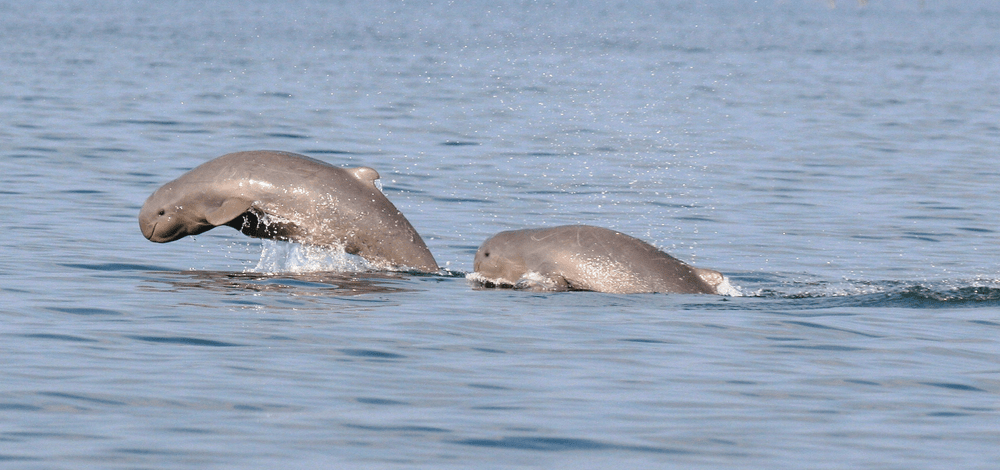
Like the indo-pacific humpback dolphin, the Irrawaddy dolphin is also an endangered dolphin species with a depressingly declining population.
Again, its main threats are human interference and pollution. This fascinating oceanic creature dwells in multiple separate areas across coastal southeastern Asia.
At first, it was classified as a subspecies, although in 2005, it was deemed a distinct species.
The Irrawaddy dolphin is a euryhaline species and can move between fresh and saltwater. While it can dwell in rivers, it is not a true river dolphin and favors oceanic waters.
In terms of looks, this mammal is hard to confuse because it has no beak and has a pretty streamlined head compared to other types of dolphins. Moreover, it has a blunt snout and a high forehead.
Characteristics
- Dark gray back and light gray underside
- Short dorsal fin with long and board pectoral fins
- Adults are up to 8 feet long and can weigh as much as 400 lbs. (181 kg)
- The dolphin breed pretty much resembles the beluga
- Shy but curious cetaceans
- They refer to traveling in smaller groups of 2- 6
19. Melon-Headed Whale (Peponocephala Electra)
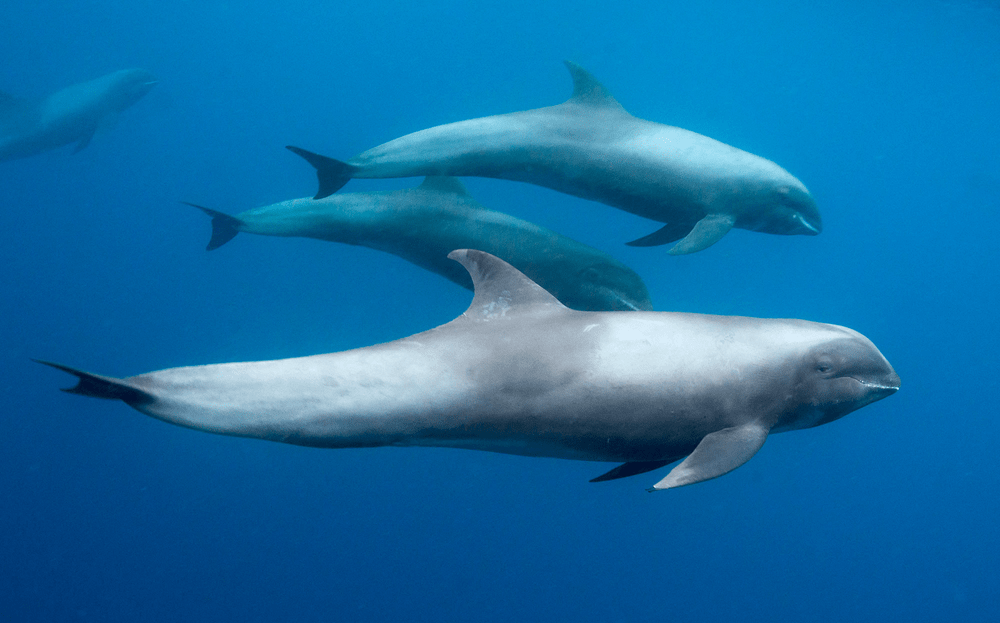
The melon-headed whale is also known as the Electra dolphin or little killer whale. As expected, it gets its name “melon-headed” from the shape of its head-large and round.
You can find this dolphin species worldwide in deep subtropical or tropical waters, and there are distinct populations around the Philippines and Hawaii.
Characteristics
- Light gray body with a dark gray face
- Tall dorsal fin with a pointed top and long, pointed flippers
- Sickle-shaped dorsal fin
- Reach sexual maturity at the age of 7
- Form strong interactive bonds within the hunting groups of up to 100 individuals
20. Peale’s Dolphin (Sagmatias australis)
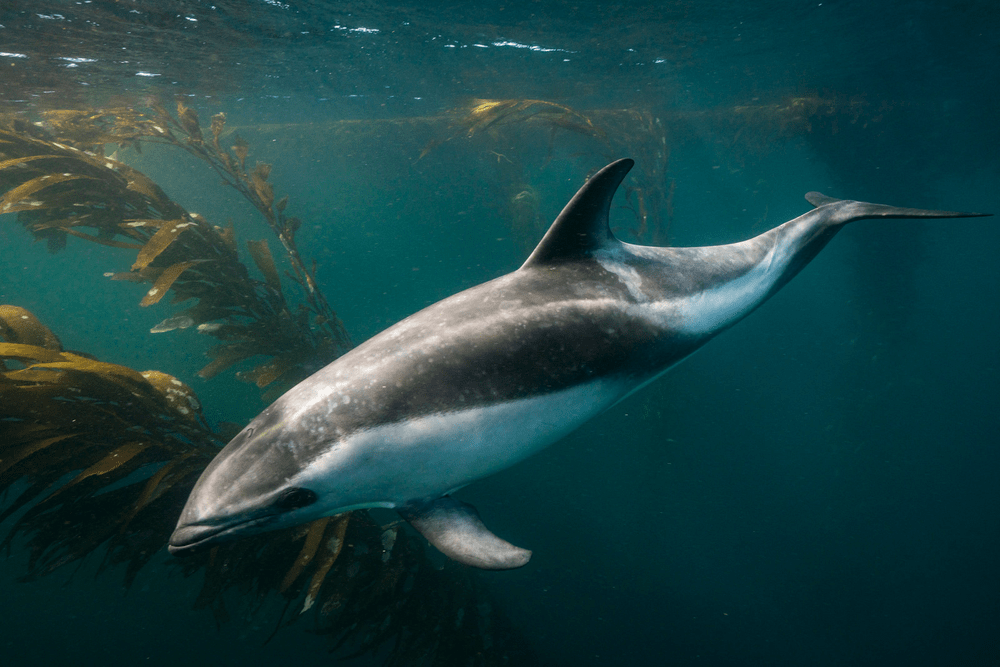
The Peale’s dolphin also goes by the name black-chinned dolphin. It is a small oceanic cetacean that dwells mainly in southern South America’s Tierra del Fuego.
From a distance, it’s easy to mistake this dolphin species for the dusky dolphin. However, once you’re within proximity, you will realize that it has relatively larger white patches on its underside.
Like most types of dolphins, the Peale’s dolphin is a social creature that travels in groups of 5-20 individuals. Occasionally, the smaller pods join a larger group of about 100 individuals to socialize and find credible mates.
Characteristics
- Dark gray face and chin with black back, white belly, and off-white patches on the sides
- Relatively small and pointed flippers and a sickle-shaped dorsal fin
- Can grow to a length of up to 6.8 feet and weigh about 253 lbs. (115 kg)
- Playful and often bow-ride or wake-surf around water vessels
21. Striped Dolphin (Stenella coeruleoalba)

Lastly, we have the striped dolphin. It’s among the types of dolphins found in just about all oceans worldwide.
The striped dolphin dwells in warm temperate or tropical waters and prefers areas where the water is deep, cold, and packed with nutrients that float to the surface.
You can find large populations of the striped dolphin in the Atlantic Ocean and the Gulf of Mexico in specific.
These dolphins, too, have tight social structures and often form cohesive hunting groups of 25 – 100 individuals. They are pretty playful and acrobatic and can leap out of the water while vigorously rotating the tail before diving back.
Its most outstanding physical attribute is the two white stripes that separate the back and underside.
Characteristics
- Sleek body with a long beak and a tall, hooked dorsal fin
- Adults measure 8- 9 feet and can weigh up to 350 lbs. (158 kg)
- Pretty active, friendly, and athletic
- Reach sexual maturity when 5 – 13 years old
- Have an estimated life expectancy of 58 years
6 River Dolphin Species
The majority of types of dolphins live in oceans. However, six dolphin species have made some of the largest rivers globally their home.
These mammals inhabit the Indus, Amazon, and Ganges rivers. Unfortunately, their habitat also makes them easy to catch, making them the most endangered type of dolphin species.
1. Ganges River Dolphin (Platanista gangetica)
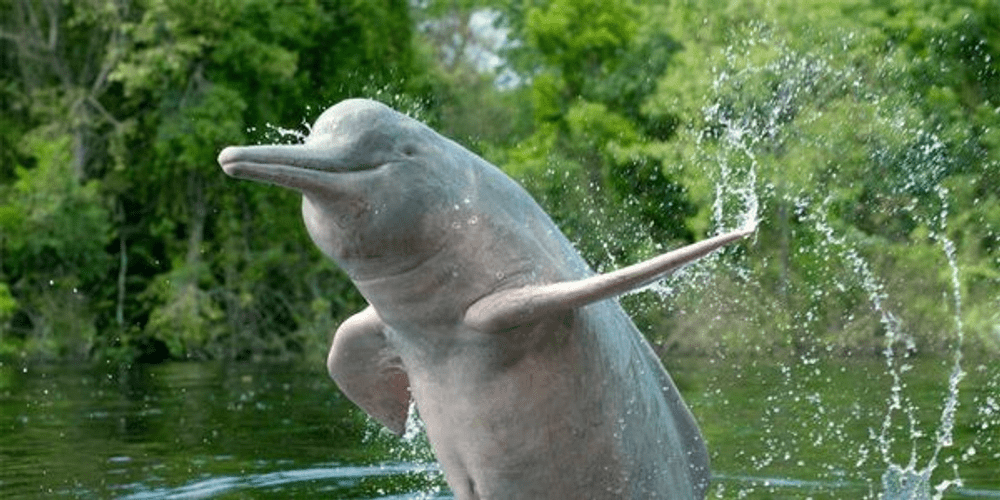
The Platanista gangetica, better known as the Ganges River Dolphin, is one of only three freshwater dolphins globally. You can find this type of dolphin in Bangladesh, Nepal, and India, where it is called shushuk or susu.
It is one of the most endangered dolphin species, with only 3,500 left.
Because the Ganges river dolphin is at threat of extinction, it is a protected animal in India. Hunting the dolphin for exotic cuisines or keeping it in captivity is illegal unless for rehabilitation or research purposes.
Unfortunately, the aquatic mammal is still at risk because of industrial and agricultural pollution as well as human activities such as fishing, irrigation, and dam creation.
Characteristics
- Sturdy body with large flippers and thin, elongated snout
- Upon maturity, the dolphin can weigh as much as 330 pounds (150 kilograms)
- Ganges River Dolphins love riding solo and don’t form tight-knit groups
- Generally blind and use ultrasonic sound to catch prey
- Females (2.67 m maximum size) are typically larger than males (2.12m max size)
- Females are sexually mature at the age of 10—12
- Mature females give birth once in about three years and have a gestation period of 9-11 months
2. Indus River Dolphin (Platanista Minor)
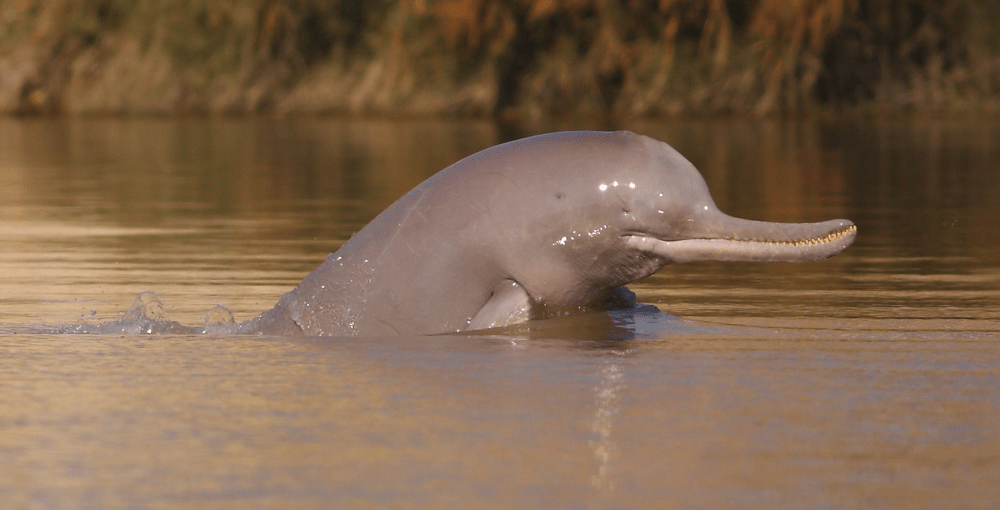
The Indus River dolphin, also known as the Platanista minor or bhulan, is yet another endangered dolphin species.
The aquatic mammal is a close relative to the Ganges River dolphin and is also called the susu. These two types of dolphins are functionally blind, although they can sense the direction of light and communicate using ultrasonic sound.
Indus river dolphins are found only in the Indus River Basin. However, like Ganges River dolphins, these aquatic mammals are also endangered by pollution and habitat degradation.
Characteristics
- Rounded, sturdy body with small triangular fins and long beak
- Gray back with a pinkish or pale white belly
- Indus River dolphins can grow to 8.5 feet long max
- Females are larger than males and can weigh about 200 pounds
- Small eyes that are functionally blind with a rounded forehead for collecting sound
- Like roaming in groups of up to 10, although they can be found individually
- Females reach sexual maturity at about 10 years and have a 30-year life expectancy
3. Amazon River Dolphin (Inia geoffrensis)
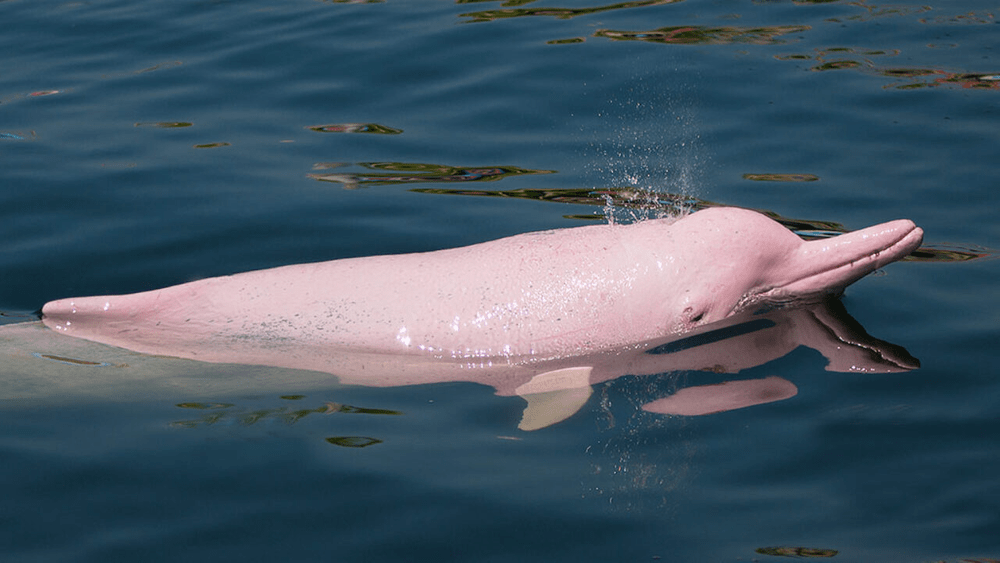
The Amazon River dolphin is the largest type of river dolphin.
It’s commonly called the bufeo, pink river dolphin, or boto and lives primarily in the Orinoco and Amazon River Basin in Colombia, Brazil, Peru, Ecuador, Venezuela, and Guyana.
A full-grown Inia geoffrensis can weigh as much as 400 lbs. (185 kg).
Unlike the Indus River and Ganges River types of dolphins whose numbers are depressingly low, the Amazon River dolphins are in their tens of thousands.
Nevertheless, they are still at risk because of contamination and human activities.
Characteristics
- Biggest dolphin and the smartest of all freshwater dolphin species
- Amazon River dolphins come in all shades of pink, including rosy, bright, and gray-pink
- Bristle-like hairs on the snout and molar like teeth
- Super agile and spectacular gymnasts in water
- Can turn their neck from side to side
- 5 feet average length
- Dolphin species with the most extensive dietary range (can eat crustaceans, turtles, and over 50 types of fish)
4. Araguaian River Dolphin (Inia araguaiaensis)

Researchers recently discovered a new type of river dolphin—the Araguaian river dolphin.
Studies are still undergoing to understand this dolphin species better, although there are a few verified facts. For instance, the aquatic mammal primarily lives in Brazil’s Araguaia–Tocantins River Basin.
While it resembles the Amazon River dolphin, it has a unique DNA structure that makes it unique.
Moreover, the Araguaia river dolphins in the wild are only about 1,500. They are grayish-pink and have a body length that ranges between 5 and 8.5 feet (1.53—2.6m).
The dolphins love riding solo, although you can occasionally find them in groups.
Characteristics
- Prominent forehead and a considerably long snout
- Functionally blind with poorly developed vision
- Communicates using longer calls and whistles compared to other types of dolphins
- Skittish and hard to approach
5. Bolivian River Dolphin (Inia boliviensis)
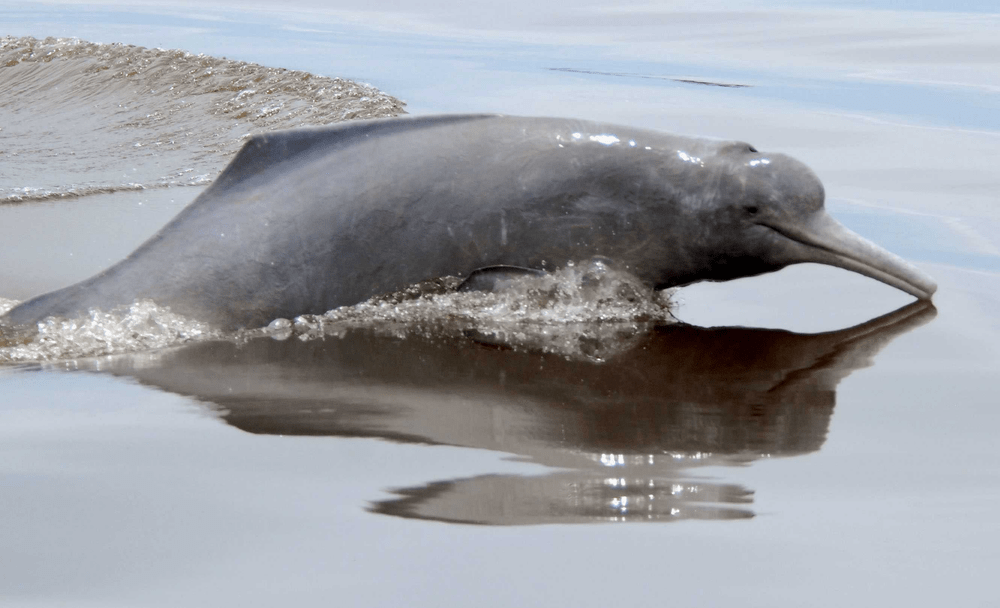
Like the Araguaia River Dolphin, the Bolivian river dolphin is also a close cousin of the Amazon River dolphin.
Again, researchers debate whether the dolphin species is genetically distinct, although DNA tests show variations between this mammal and other dolphins.
The Bolivian river dolphin, also known as the bufeo, inhabits in the Amazon’s Upper Madeira Basin in Bolivia.
While many argue that they mingle with the Amazon and Bolivian river dolphins, they don’t. Instead, they remain in separate habitats because of the extensive series of rapids in the water.
Bolivian river dolphins have a population of fewer than 25,000 individuals. In 2012, Bolivian President Evo Morales signed a law declaring the endangered species a national treasure protected by the law.
Characteristics
- Grayish pink in color
- Smaller skull and longer body compared to the Amazon river dolphin
- Considerably more teeth
- Can grow as long as 2.8 meters
- Mature Bolivian dolphins can weigh as much as 396 lbs. (180 kg)
6. Tucuxi (Sotalia fluviatilis)
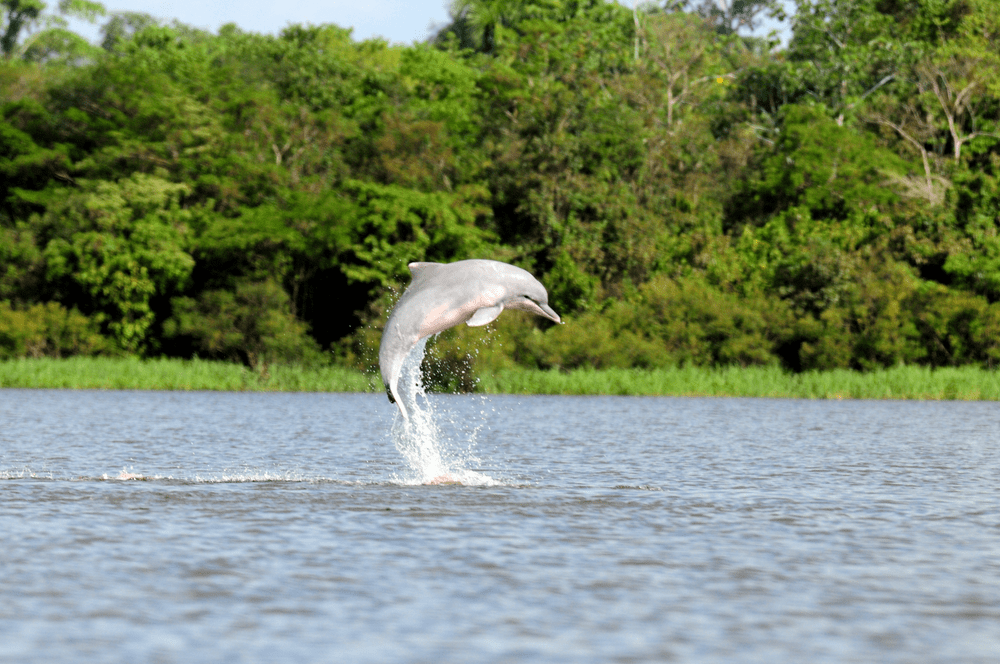
The Tucuxi also dwells in the Amazon River Basin in Brazil, Ecuador, Colombia, and Peru. Compared to other freshwater dolphins, this dolphin species is pretty unique because of its facial structure.
It resembles the bottlenose dolphin but has a much smaller frame.
Tucuxi dolphins are close relatives of the costero dolphin. They are light gray in color, although their flukes, fins, skull, and upper snout are darker than the sides and lower half body.
Mature adults can weigh over 120 pounds and grow as long as 6 feet. Yet, research shows that the tucuxi community contains no more than 30,000 individuals.
Characteristics
- Midsize freshwater dolphin
- Acrobatic but skittish and difficult to approach
- Mainly feeds on fish and shrimp
- Complex social structure and often feed in groups of 10—15
How Smart Are Dolphins?
Dolphins are best known for their intelligence, social interactions, and complex problem-solving skills. But, contrary to popular belief, they are not more intelligent than humans.
However, they are second only to humans in their brain-to-body size ratio and rank high on the list of the most intelligent animals worldwide.
According to studies conducted on dolphins in captivity and the wild, these marine mammals have incredible ability to learn as individuals. The best part is that the “learned” dolphin can pass the knowledge mastered to its friends and relatives.
Apart from their social and emotional intelligence, dolphins are also acutely self-aware. Unlike most animals, they can recognize themselves in a mirror.
Moreover, these creatures can communicate, use tools, and researchers claim they are human’s cognitive cousins. This is mainly because of the high brain functions that allow them to know, think, judge, and remember.
Final Thoughts on the Different Types of Dolphins
The world of dolphins is simply fascinating. But, now you know that what you’ve seen in aquatic theme parks and local aquariums is merely a tiny fraction of the types of dolphins globally.
Note that our list is not exhaustive, and we may have left out a few dolphin species, mainly breeds that are hard to study or poorly researched by scientists.
We hope you find this guide helpful and informative. Feel free to drop a comment if you feel there’s something we left out.
Do you have any dolphin-related stories you would care to share with us? Perhaps you have worked with these amazing creatures or have other dolphin-based knowledge you would like to share. The comments are open, so don’t be shy.





That must have been an amazing experience.
I worked in shows that had dolphins like the spinner dolphin, The Pacific bottlenose dolphin, and the Steno. I also rode a false killer whale in one part of the show. These are fabulous animals. Sea Life Park. Hawaii
I worked in shows that had dolphins like the spinner dolphin, The Pacific bottlenose dolphin, and the Steno. I also rode a false killer whale in one part of the show. These are fabulous animals.